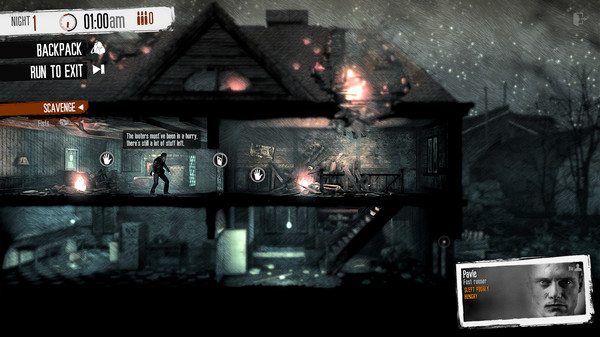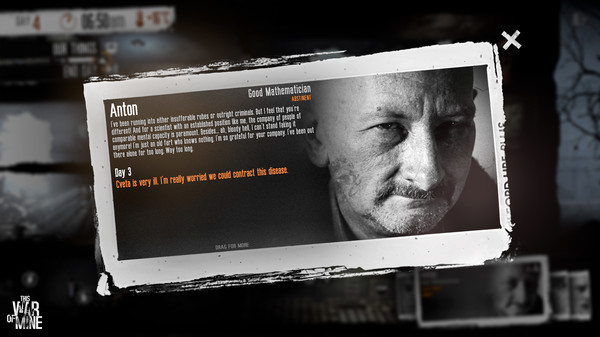
This War of Mine – Game Club Recap
This month we tackled a game with dark tones and dark themes, This War of Mine by 11 bit Studios, a much different type of game from the Anomaly series that put them on the map. This War of Mine lets you play out the story of survivors of a non specific war in a city under siege, making decisions to try to keep them happy, healthy, and hopefully alive. It is a beautifully drawn 2D side-scrolling game in a charcoal art style that is very unique and fits the bleak setting of the game world. It falls into the rogue-like category by including permadeath of your characters, random events in the game and encouraging multiple playthroughs to really understand the systems of the game and get the most out of it, though it is very different from the heavily action oriented rogue-likes such as Rogue Legacy and Spelunky.
 One thing we all liked was how the game is structured in two distinct phases: in daytime, the player is in their safe house tending to their characters needs via food, rest, and medical care. They also get a chance to craft items and upgrade their home’s furnishings, defenses, and workbenches, that are the means to crafting better and better items. The second phase is the night where the player decides which of their characters will rest, guard the house, or go out scavenging. Where the day cycle is fairly relaxed and involves a lot of management of your characters and home, the night is a tense affair where you often put your characters in dangerous situations while you hunt for needed crafting materials, food and weapons to help your survivors make it through to the cease-fire on day 30. We liked how this dichotomy gave us some tense moments to deal with, and then a break period to catch your breath and regroup for the next night’s challenges. We also found it interesting that the time you spend bonding with the characters is during the down time where you get to read their bio’s that show how they react to events that happened during the different cycles of the game.
One thing we all liked was how the game is structured in two distinct phases: in daytime, the player is in their safe house tending to their characters needs via food, rest, and medical care. They also get a chance to craft items and upgrade their home’s furnishings, defenses, and workbenches, that are the means to crafting better and better items. The second phase is the night where the player decides which of their characters will rest, guard the house, or go out scavenging. Where the day cycle is fairly relaxed and involves a lot of management of your characters and home, the night is a tense affair where you often put your characters in dangerous situations while you hunt for needed crafting materials, food and weapons to help your survivors make it through to the cease-fire on day 30. We liked how this dichotomy gave us some tense moments to deal with, and then a break period to catch your breath and regroup for the next night’s challenges. We also found it interesting that the time you spend bonding with the characters is during the down time where you get to read their bio’s that show how they react to events that happened during the different cycles of the game.
This mechanic to split up the game was welcome, but we wished there was a way to skip ahead in smaller increments than just day to night and back, since there tends to be a lot of waiting around in the day cycle for certain things to happen (such as collecting rain water, waiting on crops to grow, or characters to rest). It would have been useful to have a way to skip past the waiting and get back to the game quicker. Both day and night cycles are governed by a timer that advances as you play through the cycle, so it seems like it would have been easy enough to let the player choose to advance it by increments of their choosing. The timer is an interesting mechanic as it forces the player to stay focused on their tasks during both cycles and get them done before the cycle ends.
We liked were how the game tutorialized itself by showing you everything you needed to know to play the game in the starting safe house, and then gave other important information by having the characters talk about things happening and how they were feeling, like “A shovel would help me get through this pile a lot easier”. The game features a trading mechanic that the player will encounter during the day cycles, and we thought that was a better solution for the game’s economy than straight currency. It really fit the situation that the game was trying to portray, where an impromptu barter economy would spring up in a survival type of situation. We also really liked that the post-game summary is all about how your actions impacted other people’s (NPCs) lives in the game during your playthrough, rather than just being a list of meaningless statistics.
 While the post game summary was a nice touch and made it feel more like a living world, the actual gameplay did little make the player feel like their actions were having an impact on the world around them. The game is full of random events that give the player a chance to make choices that will ultimately effect the health and well-being of your party of survivors, but none of it seems to have an impact on anything going on in the game world, and that felt like a missed opportunity to us – though it may have been hard to pull off and maintain the randomness of the game at the same time. We also wished there had been more interaction options with the NPCs than what you are presented with – the options were basically run away or attack. Most of the survivors seem to want to get along with their fellow inhabitants of the city, but the game doesn’t give you many ways of doing that other than completely avoiding human contact, which doesn’t leave you with much chance of survival.
While the post game summary was a nice touch and made it feel more like a living world, the actual gameplay did little make the player feel like their actions were having an impact on the world around them. The game is full of random events that give the player a chance to make choices that will ultimately effect the health and well-being of your party of survivors, but none of it seems to have an impact on anything going on in the game world, and that felt like a missed opportunity to us – though it may have been hard to pull off and maintain the randomness of the game at the same time. We also wished there had been more interaction options with the NPCs than what you are presented with – the options were basically run away or attack. Most of the survivors seem to want to get along with their fellow inhabitants of the city, but the game doesn’t give you many ways of doing that other than completely avoiding human contact, which doesn’t leave you with much chance of survival.
The game’s control scheme felt like it could have been a bit more polished. With just about everything being done with a left mouse click, it was easy when controlling multiple characters and actions in a tight space to accidentally click on the wrong thing or break an action while just trying to move characters around. It would have been nice to have some hot-keys to select between the PCs, and separate buttons at the least for movement and action. The control scheme and UI make it feel like a game that might have been designed for a tablet with limited input options, but when playing on a PC it would be nice to take full advantage of the inputs available to the player to make playing a little easier.
We also had wished that the inventory was a bit more accessible during the game and that crafting recipes were available at all times rather than only during the day and only at specific workbenches. That left a lot of us resorting to old school pen and paper to keep track of materials we needed, and recipes for different useful items, and what each location in the city contained so we could go back and get what we needed at a later point. This certainly adds to your feeling of minimalist living in a survival situation, but in terms of modern game design it felt a bit unnecessarily cumbersome and lacking and pulled you out of the experience more than pulling you in.
While thought-provoking, This War of Mine had a “feedback loop of depression”
Most of us didn’t think we would be going back to play This War of Mine after this month, as it had a “feedback loop of depression” and didn’t offer the sense of escapism that most people look for in video games. However, it is certainly a thought-provoking game, and one you can play for an hour or two and make fairly significant progress, as well get a sense of what it must be like to live in wartime, and how even you might react if in that situation.
For next month’s meetup we have chosen Undertale, and look forward to hopefully seeing some more new faces there to discuss it with us.